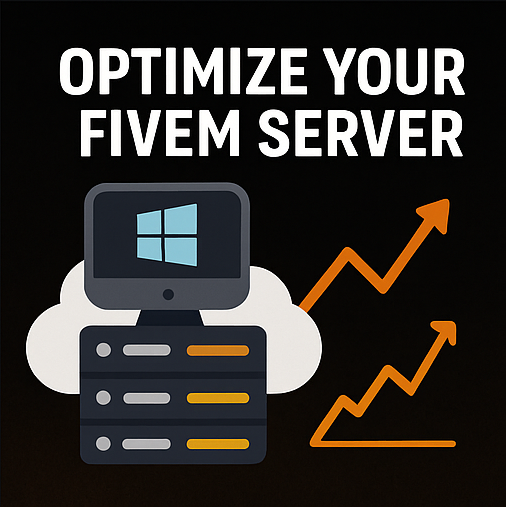Choosing the right FiveM server base is the foundation of your roleplay community’s success in 2025. With countless base options ranging from lightweight frameworks to fully loaded ESX or QBCore setups, server owners face a critical decision that will shape gameplay, performance, and player retention. This guide breaks down the essential factors—from framework architecture and resource compatibility to hosting requirements—helping you select the best FiveM server base tailored to your vision, technical skills, and budget.
Understanding FiveM Server Base Types in 2025
The term FiveM server base refers to the foundational framework and pre-configured scripts that define your server’s core functionality. In 2025, three dominant base types dominate the FiveM ecosystem: ESX Legacy, QBCore, and custom standalone frameworks. Each offers distinct advantages depending on your roleplay style, developer expertise, and long-term scalability goals.
ESX Legacy: The Industry Standard
ESX Legacy remains the most popular FiveM server base for traditional roleplay servers. Built on a robust MySQL database structure and Lua scripting, ESX provides comprehensive job systems, inventory management, banking, and vehicle ownership out of the box. Its maturity means thousands of compatible resources are available on platforms like GitHub and CFX.re forums, making it ideal for server owners who want extensive plugin support without reinventing the wheel.
ESX Legacy is particularly well-suited for servers hosted on Nexus Games FiveM hosting, where the AMD Ryzen 9 7950X3D processor with 16 cores and 32 threads handles the framework’s database-intensive operations effortlessly. The 1 Gbps network bandwidth ensures smooth synchronization across all ESX modules even with 100+ concurrent players.
QBCore: Modern and Modular
QBCore has rapidly gained traction as a FiveM server base that prioritizes modularity and performance optimization. Unlike ESX’s monolithic structure, QBCore uses a component-based architecture where each system (jobs, inventory, player management) operates independently. This design reduces resource conflicts and simplifies troubleshooting—critical advantages when managing a growing server.
QBCore requires more initial configuration than ESX but rewards experienced developers with greater flexibility. The framework’s lighter footprint makes it an excellent match for servers utilizing NVMe SSD storage on platforms like Nexus Games Linux VPS, where fast disk I/O accelerates script loading and database queries.
Custom Standalone Frameworks
For developers seeking complete control, building a custom FiveM server base from scratch offers unparalleled flexibility. Standalone frameworks built with pure Lua or integrated with Node.js backends enable unique gameplay mechanics impossible with pre-built bases. However, this path demands significant development time and expertise in FiveM’s native functions, networking protocols, and anti-cheat integration.
Custom frameworks thrive on high-performance infrastructure like Nexus Games’ DDR5 ECC RAM configurations (32–128 GB), which provide the memory headroom needed for experimental scripts and real-time data processing without server lag.
Key Factors When Choosing Your FiveM Server Base
Selecting a FiveM server base extends beyond framework popularity. Five critical factors should guide your decision to ensure long-term success and player satisfaction.
1. Community and Support Ecosystem
The size and activity of a framework’s community directly impacts your ability to troubleshoot issues and find compatible resources. ESX Legacy boasts the largest community, with active Discord servers, weekly script releases, and extensive documentation. QBCore’s community, while smaller, is highly engaged and focused on cutting-edge features. Custom frameworks require self-reliance or hiring dedicated developers.
2. Resource Compatibility and Availability
Before committing to a FiveM server base, audit available resources for your planned server features. ESX dominates in quantity—job scripts, vehicle shops, housing systems, and admin tools number in the thousands. QBCore’s library is growing rapidly but may require adapting ESX scripts or commissioning custom work. Standalone frameworks start from zero unless you integrate open-source components.
3. Performance and Scalability Requirements
Framework choice impacts server performance under load. ESX’s comprehensive feature set increases baseline resource consumption, requiring robust hosting solutions. QBCore’s optimized architecture reduces CPU overhead, allowing higher player counts on equivalent hardware. Custom frameworks’ performance varies wildly based on code quality.
| Framework | Recommended CPU | Minimum RAM | Typical Player Cap |
| ESX Legacy | AMD Ryzen 9 7950X3D | 32 GB DDR5 ECC | 128 players |
| QBCore | AMD Ryzen 9 7950X3D | 32 GB DDR5 ECC | 150+ players |
| Custom Framework | AMD Ryzen 9 7950X3D | 64 GB DDR5 ECC | Variable |
4. Development Skill Level
Assess your team’s technical capabilities honestly. ESX Legacy offers the gentlest learning curve with extensive tutorials and plug-and-play resources—perfect for first-time server owners. QBCore demands intermediate Lua knowledge and comfort with modular programming concepts. Custom frameworks require advanced scripting, database management, and FiveM API mastery.
5. Long-Term Maintenance and Updates
Framework maintenance affects server longevity. ESX Legacy receives regular updates but the massive resource ecosystem means compatibility issues arise frequently after updates. QBCore’s tighter core reduces breaking changes but fewer legacy resources exist. Custom frameworks place the update burden entirely on your team.
Matching Your FiveM Server Base to Hosting Infrastructure
Your chosen FiveM server base must align with your hosting solution’s capabilities. Mismatched infrastructure leads to poor performance, player disconnections, and wasted resources.
Dedicated FiveM Hosting vs VPS Solutions
Nexus Games offers two primary pathways for FiveM servers: dedicated game hosting via the Nexus Panel and flexible VPS options with Pterodactyl pre-installed. Dedicated hosting provides optimized FiveM configurations, automatic backups, and one-click resource installation—ideal for ESX Legacy servers where ease-of-use matters. The Pterodactyl VPS solution grants full root access, enabling advanced QBCore customization and custom framework development while maintaining resource isolation.
Server Resource Allocation Best Practices
Different FiveM server bases consume resources distinctly. ESX Legacy with 50+ additional scripts typically uses 6-8 GB RAM at baseline, scaling to 16 GB with 64 players online. QBCore’s leaner design starts at 4 GB, reaching 12 GB under similar load. Allocate at least 50% overhead to prevent memory-related crashes during peak hours.
NVMe SSD storage accelerates database operations critical to both ESX and QBCore. The sub-millisecond latency of NVMe drives eliminates the stuttering that occurs with traditional SATA SSDs when loading player inventories or processing transactions. Nexus Games’ NVMe infrastructure ensures that even database-heavy bases like ESX Legacy maintain sub-50ms tick rates.
Network Performance Considerations
FiveM servers synchronize vast amounts of data—player positions, vehicle states, entity creation—requiring consistent bandwidth. The 1 Gbps network connectivity provided by Nexus Games prevents bottlenecks even during high-action scenarios with 100+ players and complex vehicle physics. Framework choice affects bandwidth usage: ESX’s entity synchronization can spike to 50 Mbps under load, while QBCore’s optimized network events typically peak at 30 Mbps for equivalent player counts.
Step-by-Step: Installing Your Chosen FiveM Server Base
Once you’ve selected your FiveM server base, proper installation ensures stability and prevents common configuration errors.
Installing ESX Legacy on Nexus Panel
The Nexus Games panel simplifies ESX Legacy deployment through automated installers. After provisioning your FiveM server, navigate to the resource management section and select “Install ESX Legacy.” The system automatically configures MySQL databases, imports essential SQL tables, and sets up core resources including es_extended, mysql-async, and base jobs.
# Verify ESX installation via console
ensure es_extended
ensure esx_ambulancejob
ensure esx_policejob
restart sessionmanagerPost-installation, configure server.cfg to enable ESX’s admin system and adjust onesync settings for your target player count. Nexus Games’ AMD Ryzen 9 7950X3D handles OneSync Infinity configurations effortlessly, enabling 128+ player slots without performance degradation.
Deploying QBCore on Linux VPS
QBCore installation on a Linux VPS requires manual setup but offers deeper customization. SSH into your Nexus Games VPS and clone the QBCore repository:
cd /home/fivem/server-data/resources
git clone https://github.com/qbcore-framework/qb-core.git [qb]
git clone https://github.com/qbcore-framework/qb-smallresources.git [qb]
cd qb-core
npm installImport the QBCore SQL file into your MySQL database, then configure qb-core/config.lua with your server details. QBCore’s modular structure means you’ll add additional repositories (qb-inventory, qb-policejob, qb-garages) individually, allowing precise control over enabled features.
Building a Custom Framework Foundation
Custom FiveM server base development begins with a minimal server structure. Create a resource folder structure:
server-data/
└── resources/
└── [core]/
├── player-management/
├── database-wrapper/
└── framework-init/Develop your player-management resource with essential functions—spawn handling, character creation, and session persistence. Utilize FiveM’s native MySQL connector for database operations, ensuring queries are parameterized to prevent SQL injection. The 64 GB DDR5 ECC RAM available in Nexus Games configurations allows aggressive query caching to minimize database roundtrips.
Optimizing Your FiveM Server Base for Peak Performance
Installation is just the beginning. Optimizing your FiveM server base ensures smooth gameplay and maximizes your hosting investment.
Database Optimization Techniques
Both ESX and QBCore rely heavily on MySQL databases. Regular optimization prevents performance degradation as player data accumulates. Schedule weekly OPTIMIZE TABLE commands on heavily-accessed tables like owned_vehicles, users, and jobs. Enable MySQL query caching in my.cnf to reduce repetitive query overhead.
# Example MySQL optimization for ESX
OPTIMIZE TABLE users;
OPTIMIZE TABLE owned_vehicles;
ANALYZE TABLE user_inventory;Nexus Games’ NVMe storage accelerates database I/O, but proper indexing multiplies these gains. Ensure player identifier columns use PRIMARY KEY or UNIQUE indexes, and add composite indexes to frequently joined columns.
Script Profiling and Resource Management
Use FiveM’s built-in profiler to identify resource-hungry scripts:
profiler record 60
profiler viewIdentify scripts consuming excessive CPU time (>1.0ms per tick) and either optimize them or replace with efficient alternatives. ESX servers often suffer from poorly-coded vehicle shops or phone resources. QBCore’s component isolation makes it easier to disable problematic modules without affecting core functionality.
OneSync Configuration for Maximum Capacity
OneSync Infinity enables player counts beyond 32 but requires careful tuning. In server.cfg, configure appropriate entity routing buckets and distance culling:
set onesync on
set onesync_enableInfinity 1
set onesync_enableBeyond 1
set onesync_distanceCullVehicles 500.0
set onesync_population trueThe 32 threads of Nexus Games’ AMD Ryzen 9 7950X3D distribute OneSync’s computational load efficiently, maintaining stable tick rates even with 150 players and thousands of synchronized entities.
In conclusion, selecting the optimal FiveM server base in 2025 demands balancing framework capabilities, your technical expertise, and hosting infrastructure quality. ESX Legacy offers unmatched resource availability and community support, QBCore provides modern architecture and performance optimization, while custom frameworks deliver total creative freedom. Align your choice with robust hosting solutions like Nexus Games’ AMD Ryzen 9 7950X3D-powered servers, DDR5 ECC memory, and NVMe storage to ensure your FiveM community thrives. Whether you’re launching your first roleplay server or migrating an established community, the right base paired with professional hosting creates the foundation for immersive gameplay and sustainable growth.
FAQ
Can I switch my FiveM server base from ESX to QBCore after launch?
Migrating between frameworks is technically possible but complex and time-consuming. You’ll need to export player data from ESX’s MySQL tables, transform it to match QBCore’s schema, and replace all resources. Expect 1-2 weeks of development work and thorough testing. Most successful migrations occur during low player activity periods or planned server wipes. Consider framework choice carefully before launch to avoid this costly process.
How much RAM does a FiveM server base actually need for 64 players?
A baseline ESX Legacy setup requires 8-12 GB RAM for 64 concurrent players, while QBCore typically needs 6-10 GB for equivalent load. However, these figures increase significantly with additional resources—heavy scripts like custom phone systems, advanced inventory UIs, or detailed vehicle handling can add 2-4 GB each. Allocate 16-24 GB total RAM to provide comfortable overhead and prevent out-of-memory crashes during peak activity. Nexus Games’ 32 GB DDR5 ECC configurations provide ample room for growth.
Do ESX and QBCore resources work interchangeably between frameworks?
No, ESX and QBCore resources are not directly compatible due to fundamental architectural differences in how they handle player data, events, and callbacks. ESX uses shared objects and TriggerServerEvent patterns, while QBCore relies on its own core functions and framework-specific exports. Converting resources requires rewriting core function calls and adapting data structures. Some developers release dual-framework versions, but most resources target only one framework. Choose your base considering the available resource ecosystem for your planned server features.




